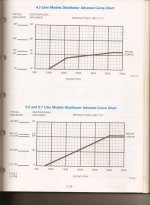captain_peter
Contributing Member
Hello ones again, I get tired of scratching my head alone so I like to involve you guys who are interested.
While I was tuning the engines my friend told me that I should find out what's the distributer's advance curve. On a general manuel it showed at 1000 rpm 8 btdc at 2000 26 btdc. I like to find out what's the degrees for my engines ( 4.3 lt. Gmc. 6 cyl. 4 bbl carbs, prestolite distributors .) If any body have this information at hand and like to share it will be very appreciated.
While I was tuning the engines my friend told me that I should find out what's the distributer's advance curve. On a general manuel it showed at 1000 rpm 8 btdc at 2000 26 btdc. I like to find out what's the degrees for my engines ( 4.3 lt. Gmc. 6 cyl. 4 bbl carbs, prestolite distributors .) If any body have this information at hand and like to share it will be very appreciated.


